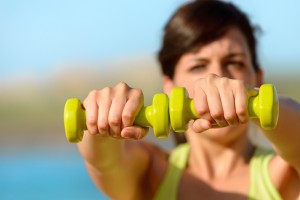4 Easy Fitness Habits for Every Workout Routine
Diet and exercise both play a part in a patient’s weight loss journey. Although diet determines the number on the scale, exercise is a critical fitness tool. An active lifestyle can improve moods, metabolism, and motivation!
Check out these easy fitness habits that you can incorporate into any workout routine!

Finding An Easy Weight Management Exercise Routine
Ultimately, do what’s right for you – find an exercise routine that challenges your body, but don’t wreck yourself. If you have previous health conditions, be sure to exercise with caution.
We recommend a full-body exercise circuit 3-5 times a week. Rest 2-3 days if needed. Follow your weight-lifting with 45 minutes of moderate aerobic (cardio) exercise. Cardio can be done every day.
If you get bored, cross train with different types of exercise. Use the bike one day, the treadmill the next, the elliptical the next, and so on. A large cardio session should really follow weightlifting (not come before it).
Don’t Hate; Hydrate!

Stay hydrated throughout the entire day. Drink at least 20 oz. of water with each meal to start. To calculate how much water you need daily, take your body weight and divide it by two. This number is how many ounces of water you should drink daily. If you sweat a lot when you work out, drink extra to replenish the water you lost.
Refuel
If you are not participating with our OptiFast program, then the best diet is high protein and high fiber, both of which keep you feeling full. Refined sugars and carbohydrates contribute to weight gain and health problems. For example, eating a raw, fresh apple causes a much lower spike in blood glucose than drinking apple juice. Why? The apple contains fiber and is bound with enzymes that help food to digest naturally.
If carbohydrates are a must, then steer toward complex carbohydrates like unprocessed whole grain oats and quinoa. Your body needs time to digest these, but it immediately stores refined sugars as fat.
Be aware of your caloric intake. Our inBody machine will show your basal metabolic rate, which is how many calories your body burns throughout the day with no physical activity. Your BMR is a good estimate of how many calories you should be eating in a day. As we age, we lose muscle and our metabolic rate drops, so we need fewer calories.
Adding muscle allows us to eat more without gaining fat, but it’s possible to gain fat from eating too much “good food.” If you eat more than what your body uses in a day, your body will store it as fat. If overeaten, lean chicken protein, eggs, peanut butter, and fruits can all be stored as excess fat.
Exercise Recovery Program
After a workout, recovery is essential to muscle function and building. The best recovery program is a healthy diet, plenty of water, and good sleep on a consistent basis.
For most people, starting out with basic workouts such as 30-60 minutes of moderate cardio, or even a whole body circuit with moderate weights, requires moderate recovery.
For best results, proper hydration before, during, and after a workout is absolutely crucial. An extra protein shake after the gym is sometimes recommended, but 90% of Americans get enough protein in their daily diets so that the extra shake isn’t necessary (unless you are an elite athlete or bodybuilder).
When you’re starting out, switching which part of the body you work out each day can help ease soreness. Icing sore muscles can help as well.
The key to a healthy exercise routine is consistency. Fitness is one of the most essential benefits for maintaining a healthy life.
